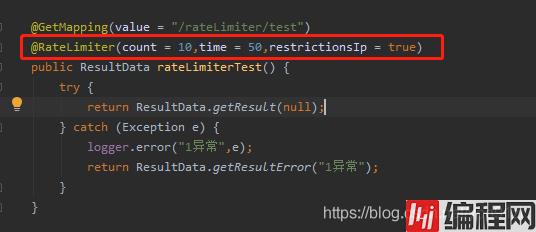Python 官方文档:入门教程 => 点击学习
Redis支持lua脚本的主要优势 LUA脚本的融合将使Redis数据库产生更多的使用场景,迸发更多新的优势: 高效性:减少网络开销及时延,多次redis服务器网络请求的操作,使用L
LUA脚本的融合将使Redis数据库产生更多的使用场景,迸发更多新的优势:
自己也是第一次在工作中使用lua这种语言,记录一下
创建Lua文件req_ratelimit.lua
local key = KEYS[1] --限流KEY
local limitCount = tonumber(ARGV[1]) --限流大小
local limitTime = tonumber(ARGV[2]) --限流时间
local current = redis.call('get', key);
if current then
if current + 1 > limitCount then --如果超出限流大小
return 0
else
redis.call("INCRBY", key,"1")
return current + 1
end
else
redis.call("set", key,"1")
redis.call("expire", key,limitTime)
return 1
end
自定义注解RateLimiter
package com.shinedata.ann;
import java.lang.annotation.ElementType;
import java.lang.annotation.Retention;
import java.lang.annotation.RetentionPolicy;
import java.lang.annotation.Target;
@Target({ElementType.TYPE, ElementType.METHOD})
@Retention(RetentionPolicy.RUNTIME)
public @interface RateLimiter {
String key() default "rate.limit:";
int time() default 1;
int count() default 100;
boolean restrictionsIp() default false;
}定义切面RateLimiterAspect
package com.shinedata.aop;
import com.shinedata.ann.RateLimiter;
import com.shinedata.config.redis.RedisUtils;
import com.shinedata.exception.RateLimiterException;
import org.apache.commons.lang3.StringUtils;
import org.aspectj.lang.ProceedingJoinPoint;
import org.aspectj.lang.annotation.Around;
import org.aspectj.lang.annotation.Aspect;
import org.aspectj.lang.reflect.MethodSignature;
import org.slf4j.Logger;
import org.slf4j.LoggerFactory;
import org.springframework.beans.factory.annotation.Autowired;
import org.springframework.context.annotation.Configuration;
import org.springframework.core.io.ClassPathResource;
import org.springframework.data.redis.core.RedisTemplate;
import org.springframework.data.redis.core.script.DefaultRedisScript;
import org.springframework.scripting.support.ResourceScriptSource;
import org.springframework.stereotype.Component;
import org.springframework.WEB.context.request.RequestContextHolder;
import org.springframework.web.context.request.ServletRequestAttributes;
import javax.annotation.PostConstruct;
import javax.servlet.Http.httpservletRequest;
import java.io.Serializable;
import java.lang.reflect.Method;
import java.util.Collections;
import java.util.List;
@Aspect
@Component
public class RateLimiterAspect {
private final Logger logger = LoggerFactory.getLogger(this.getClass());
private static ThreadLocal<String> ipThreadLocal=new ThreadLocal();
private DefaultRedisScript<Number> redisScript;
@PostConstruct
public void init(){
redisScript = new DefaultRedisScript<Number>();
redisScript.setResultType(Number.class);
redisScript.setScriptSource(new ResourceScriptSource(new ClassPathResource("redis/req_ratelimit.lua")));
}
@Around("@annotation(com.shinedata.ann.RateLimiter)")
public Object interceptor(ProceedingJoinPoint joinPoint) throws Throwable {
try {
MethodSignature signature = (MethodSignature) joinPoint.getSignature();
Method method = signature.getMethod();
Class<?> targetClass = method.getDeclarinGClass();
RateLimiter rateLimit = method.getAnnotation(RateLimiter.class);
if (rateLimit != null) {
HttpServletRequest request = ((ServletRequestAttributes) RequestContextHolder.getRequestAttributes()).getRequest();
boolean restrictionsIp = rateLimit.restrictionsIp();
if(restrictionsIp){
ipThreadLocal.set(getIpAddr(request));
}
StringBuffer stringBuffer = new StringBuffer();
stringBuffer.append(rateLimit.key());
if(StringUtils.isNotBlank(ipThreadLocal.get())){
stringBuffer.append(ipThreadLocal.get()).append("-");
}
stringBuffer.append("-").append(targetClass.getName()).append("- ").append(method.getName());
List<String> keys = Collections.singletonList(stringBuffer.toString());
Number number = RedisUtils.execute(redisScript, keys, rateLimit.count(), rateLimit.time());
if (number != null && number.intValue() != 0 && number.intValue() <= rateLimit.count()) {
logger.info("限流时间段内访问第:{} 次", number.toString());
return joinPoint.proceed();
}else {
logger.error("已经到设置限流次数,当前次数:{}",number.toString());
throw new RateLimiterException("服务器繁忙,请稍后再试");
}
} else {
return joinPoint.proceed();
}
}finally {
ipThreadLocal.remove();
}
}
public static String getIpAddr(HttpServletRequest request) {
String ipAddress = null;
try {
ipAddress = request.getHeader("x-forwarded-for");
if (ipAddress == null || ipAddress.length() == 0 || "unknown".equalsIgnoreCase(ipAddress)) {
ipAddress = request.getHeader("Proxy-Client-IP");
}
if (ipAddress == null || ipAddress.length() == 0 || "unknown".equalsIgnoreCase(ipAddress)) {
ipAddress = request.getHeader("WL-Proxy-Client-IP");
}
if (ipAddress == null || ipAddress.length() == 0 || "unknown".equalsIgnoreCase(ipAddress)) {
ipAddress = request.getRemoteAddr();
}
// 对于通过多个代理的情况,第一个IP为客户端真实IP,多个IP按照','分割
if (ipAddress != null && ipAddress.length() > 15) {
// "***.***.***.***".length()= 15
if (ipAddress.indexOf(",") > 0) {
ipAddress = ipAddress.substring(0, ipAddress.indexOf(","));
}
}
} catch (Exception e) {
ipAddress = "";
}
return ipAddress;
}
}Spring data redis提供了DefaultRedisScript来使用lua和redis进行交互,具体的详情网上很多文章,这里使用ThreadLocal是因为IP存在可变的,保证自己的线程的IP不会被其他线程所修改,切记要最后清理ThreadLocal,防止内存泄漏
RedisUtils工具类(方法太多,只展示execute方法)
package com.shinedata.config.redis;
import org.checkerframework.checker.units.qual.K;
import org.springframework.beans.factory.annotation.Autowired;
import org.springframework.beans.factory.annotation.Qualifier;
import org.springframework.data.redis.core.RedisTemplate;
import org.springframework.data.redis.core.script.DefaultRedisScript;
import org.springframework.data.redis.core.script.RedisScript;
import org.springframework.stereotype.Component;
import org.springframework.util.CollectionUtils;
import javax.annotation.PostConstruct;
import java.util.List;
import java.util.Map;
import java.util.Set;
import java.util.concurrent.TimeUnit;
@Component
public class RedisUtils {
@Autowired
@Qualifier("redisTemplate")
private RedisTemplate<String, Object> redisTemplate;
private static RedisUtils redisUtils;
@PostConstruct
public void init() {
redisUtils = this;
redisUtils.redisTemplate = this.redisTemplate;
}
public static Number execute(DefaultRedisScript<Number> script, List keys, Object... args) {
return redisUtils.redisTemplate.execute(script, keys,args);
}
}自己配置的RedisTemplate
package com.shinedata.config.redis;
import org.apache.log4j.LogManager;
import org.apache.log4j.Logger;
import org.springframework.beans.factory.annotation.Qualifier;
import org.springframework.context.annotation.Bean;
import org.springframework.context.annotation.Configuration;
import org.springframework.data.redis.connection.RedisConnectionFactory;
import org.springframework.data.redis.connection.jedis.JedisConnectionFactory;
import org.springframework.data.redis.core.RedisTemplate;
import org.springframework.data.redis.serializer.GenericJackson2JSONRedisSerializer;
import org.springframework.data.redis.serializer.StringRedisSerializer;
import redis.clients.jedis.JedisPoolConfig;
@Configuration
public class RedisConfig extends RedisProperties{
protected Logger log = LogManager.getLogger(RedisConfig.class);
@Bean("jedisPoolConfig")
public JedisPoolConfig jedisPoolConfig() {
JedisPoolConfig jedisPoolConfig = new JedisPoolConfig();
// 最大空闲数
jedisPoolConfig.setMaxIdle(500);
jedisPoolConfig.setMinIdle(100);
// 连接池的最大数据库连接数
jedisPoolConfig.setMaxTotal(6000);
// 最大建立连接等待时间
jedisPoolConfig.setMaxWaitMillis(5000);
// 逐出连接的最小空闲时间 默认1800000毫秒(30分钟)
jedisPoolConfig.setMinEvictableIdleTimeMillis(100);
// 每次逐出检查时 逐出的最大数目 如果为负数就是 : 1/abs(n), 默认3
// jedisPoolConfig.setNumTestsPerEvictionRun(numTestsPerEvictionRun);
// 逐出扫描的时间间隔(毫秒) 如果为负数,则不运行逐出线程, 默认-1
jedisPoolConfig.setTimeBetweenEvictionRunsMillis(600);
// 是否在从池中取出连接前进行检验,如果检验失败,则从池中去除连接并尝试取出另一个
jedisPoolConfig.setTestOnBorrow(true);
// 在空闲时检查有效性, 默认false
jedisPoolConfig.setTestWhileIdle(false);
return jedisPoolConfig;
}
@Bean("jedisConnectionFactory")
public JedisConnectionFactory jedisConnectionFactory(@Qualifier("jedisPoolConfig")JedisPoolConfig jedisPoolConfig) {
JedisConnectionFactory JedisConnectionFactory = new JedisConnectionFactory(jedisPoolConfig);
// 连接池
JedisConnectionFactory.setPoolConfig(jedisPoolConfig);
// IP地址
JedisConnectionFactory.setHostName(redisHost);
// 端口号
JedisConnectionFactory.setPort(redisPort);
// 如果Redis设置有密码
JedisConnectionFactory.setPassword(redisPassWord);
// 客户端超时时间单位是毫秒
JedisConnectionFactory.setTimeout(10000);
return JedisConnectionFactory;
}
@Bean("redisTemplate")
public RedisTemplate<String, Object> functionDomainRedisTemplate(@Qualifier("jedisConnectionFactory") RedisConnectionFactory redisConnectionFactory) {
RedisTemplate<String, Object> redisTemplate = new RedisTemplate<>();
initDomainRedisTemplate(redisTemplate, redisConnectionFactory);
return redisTemplate;
}
private void initDomainRedisTemplate(RedisTemplate<String, Object> redisTemplate, RedisConnectionFactory factory) {
// 如果不配置Serializer,那么存储的时候缺省使用String,比如如果用User类型存储,那么会提示错误User can't cast
// to String!
redisTemplate.seTKEySerializer(new StringRedisSerializer());
redisTemplate.setHashKeySerializer(new StringRedisSerializer());
redisTemplate.setHashValueSerializer(new GenericJackson2jsonRedisSerializer());
redisTemplate.setValueSerializer(new GenericJackson2JsonRedisSerializer());
// 开启事务/true必须手动释放连接,false会自动释放连接 如果调用方有用@Transactional做事务控制,可以开启事务,Spring会处理连接问题
redisTemplate.setEnableTransactionSupport(false);
redisTemplate.setConnectionFactory(factory);
}
}全局Controller异常处理GlobalExceptionHandler
package com.shinedata.exception;
import com.fasterxml.jackson.databind.JsonMappingException;
import com.shinedata.util.ResultData;
import org.apache.commons.lang3.StringUtils;
import org.slf4j.Logger;
import org.slf4j.LoggerFactory;
import org.springframework.http.HttpStatus;
import org.springframework.web.bind.annotation.ExceptionHandler;
import org.springframework.web.bind.annotation.ResponseStatus;
import org.springframework.web.bind.annotation.RestControllerAdvice;
@RestControllerAdvice
public class GlobalExceptionHandler {
private Logger logger = LoggerFactory.getLogger(GlobalExceptionHandler.class);
@ExceptionHandler(value = RateLimiterException.class)
@ResponseStatus(HttpStatus.OK)
public ResultData runtimeExceptionHandler(RateLimiterException e) {
logger.error("系统错误:", e);
return ResultData.getResultError(StringUtils.isNotBlank(e.getMessage()) ? e.getMessage() : "处理失败");
}
@ExceptionHandler(value = Exception.class)
@ResponseStatus(HttpStatus.OK)
public ResultData runtimeExceptionHandler(RuntimeException e) {
Throwable cause = e.getCause();
logger.error("系统错误:", e);
logger.error(e.getMessage());
if (cause instanceof JsonMappingException) {
return ResultData.getResultError("参数错误");
}
return ResultData.getResultError(StringUtils.isNotBlank(e.getMessage()) ? e.getMessage() : "处理失败");
}
}使用就很简单了,一个注解搞定

补充:优化了lua为
local key = KEYS[1]
local limitCount = tonumber(ARGV[1])
local limitTime = tonumber(ARGV[2])
local current = redis.call('get', key);
if current then
redis.call("INCRBY", key,"1")
return current + 1
else
redis.call("set", key,"1")
redis.call("expire", key,limitTime)
return 1
end到此这篇关于SpringBoot+Redis+Lua分布式限流的实现的文章就介绍到这了,更多相关SpringBoot Redis Lua分布式限流内容请搜索编程网以前的文章或继续浏览下面的相关文章希望大家以后多多支持编程网!
--结束END--
本文标题: SpringBoot+Redis+Lua分布式限流的实现
本文链接: https://lsjlt.com/news/172367.html(转载时请注明来源链接)
有问题或投稿请发送至: 邮箱/279061341@qq.com QQ/279061341
2024-03-01
2024-03-01
2024-03-01
2024-02-29
2024-02-29
2024-02-29
2024-02-29
2024-02-29
2024-02-29
2024-02-29
回答
回答
回答
回答
回答
回答
回答
回答
回答
回答
0